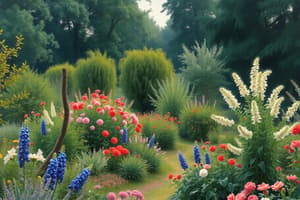Podcast
Questions and Answers
Which factor should you consider when selecting plants for a site-specific landscape design?
Which factor should you consider when selecting plants for a site-specific landscape design?
- Plant compatibility and diversity
- Budget and availability
- Client preferences and expectations
- Site context and character (correct)
What should you consider when selecting plants to enhance your landscape design?
What should you consider when selecting plants to enhance your landscape design?
- Budget and availability
- Site context and character
- Plant maintenance and management requirements (correct)
- Client preferences and expectations
Which type of plants can be used to reflect the site context and character?
Which type of plants can be used to reflect the site context and character?
- Introduced plants
- Endemic plants
- Native plants
- All of the above (correct)
What factor should you consider to avoid overspending or compromising your landscape design?
What factor should you consider to avoid overspending or compromising your landscape design?
What can you use to communicate and collaborate with your client in selecting plants?
What can you use to communicate and collaborate with your client in selecting plants?
Which factor should be considered when selecting plants for a site-specific landscape design?
Which factor should be considered when selecting plants for a site-specific landscape design?
What does microclimate refer to in the context of site-specific landscape design?
What does microclimate refer to in the context of site-specific landscape design?
Which zone can be used as a guide for plant selection in site-specific landscape design?
Which zone can be used as a guide for plant selection in site-specific landscape design?
What does design intent refer to in the context of site-specific landscape design?
What does design intent refer to in the context of site-specific landscape design?
What does function refer to in the context of site-specific landscape design?
What does function refer to in the context of site-specific landscape design?
Flashcards are hidden until you start studying
Study Notes
Selecting Plants for Landscape Design
- Consider environmental conditions like climate, soil type, and water availability to ensure plant survival and growth.
- Evaluate the purpose of the landscape, such as aesthetic appeal, wildlife habitat, or erosion control, to select appropriate plant types.
Enhancing Landscape Design
- Choose native plants to promote local biodiversity and reduce maintenance and watering needs.
- Incorporate plants with varying heights and textures to create visual interest and enhance design aesthetics.
Reflecting Site Context and Character
- Use plants that align with the regional landscape, including native flora that echoes local ecosystems.
- Choose species that represent the cultural or historical significance of the area to provide context.
Avoiding Overspending
- Establish a budget before selecting plants to prevent overspending and keep costs manageable.
- Assess long-term maintenance costs versus initial purchasing price to ensure the sustainability of the landscape.
Client Communication and Collaboration
- Use visual aids like plant catalogs, mood boards, or design software to guide discussions and get client input during the selection process.
- Engage clients by discussing their preferences, vision, and practical needs to ensure the final design reflects their desires.
Microclimate Considerations
- Microclimate refers to localized climate variations within a larger area, affecting plant growth and selection.
- Factors such as sunlight exposure, wind patterns, and proximity to structures should be assessed to optimize plant health.
Plant Selection Zones
- The USDA Plant Hardiness Zones provide a useful guideline for selecting plants suited to local climate conditions.
- Understanding these zones helps ensure plants flourish and survive the local weather extremes.
Design Intent
- Design intent encompasses the overall vision and goals of the landscape design, guiding plant selection and placement.
- It includes considerations of aesthetics, functionality, and environmental impact to achieve a cohesive design.
Function in Landscape Design
- Function relates to the practical roles of plants within the landscape, such as providing shade, privacy, or acting as windbreaks.
- It is crucial to consider how plants will interact with the environment, human activity, and overall site use when making selections.
Studying That Suits You
Use AI to generate personalized quizzes and flashcards to suit your learning preferences.




